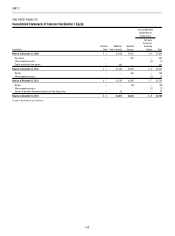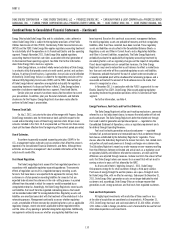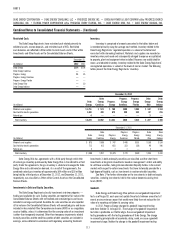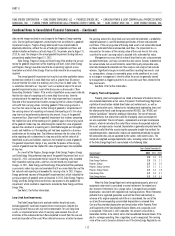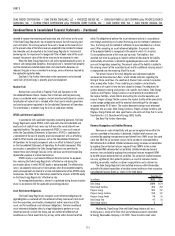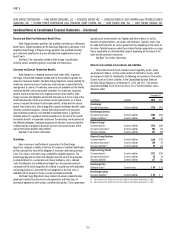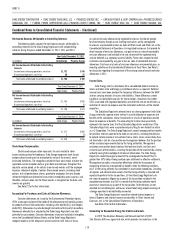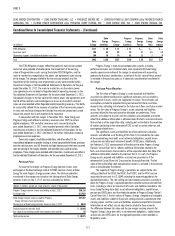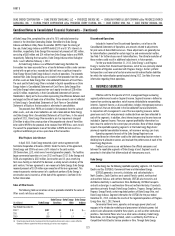Duke Energy 2012 Annual Report Download - page 133
Download and view the complete annual report
Please find page 133 of the 2012 Duke Energy annual report below. You can navigate through the pages in the report by either clicking on the pages listed below, or by using the keyword search tool below to find specific information within the annual report.
113
PART II
Combined Notes to Consolidated Financial Statements – (Continued)
DUKE ENERGY CORPORATION • DUKE ENERGY CAROLINAS, LLC • PROGRESS ENERGY, INC. • CAROLINA POWER & LIGHT COMPANY d/b/a PROGRESS ENERGY
CAROLINAS, INC. • FLORIDA POWER CORPORATION d/b/a PROGRESS ENERY FLORIDA, INC. • DUKE ENERGY OHIO, INC. • DUKE ENERGY INDIANA, INC.
allowed to recover the remaining net book value and a full return on the asset.
If the Duke Energy Registrants do not expect to recover the full remaining cost
and a full return, the carrying value of the asset is based on the lower of cost
or the present value of the future revenues expected to be provided to recover
the allowable costs discounted at the Duke Energy Registrants’ incremental
borrowing rate. An impairment is recognized if the net book value of the asset
exceeds the present value of the future revenues to be recovered in rates.
When the Duke Energy Registrants sell entire regulated operating units, or
retire or sell nonregulated properties, the original cost is removed from property
and the related accumulated depreciation and amortization balances are
reduced. Any gain or loss is recorded in earnings, unless otherwise required by
the applicable regulatory body.
See Note 10 for further information on the components and estimated
useful lives of Duke Energy’s property, plant and equipment.
Nuclear Fuel.
Nuclear fuel is classifi ed as Property, Plant and Equipment in the
Consolidated Balance Sheets. Nuclear fuel in the front-end fuel processing
phase is considered work in progress and not amortized until placed in service.
Amortization of nuclear fuel is included within Fuel used in electric generation
and purchased power-regulated in the Consolidated Statements of Operations.
The amortization is recorded using the units-of-production method.
AFUDC and Interest Capitalized.
In accordance with applicable regulatory accounting guidance, the Duke
Energy Registrants record AFUDC, which represents the estimated debt and
equity costs of capital funds necessary to fi nance the construction of new
regulated facilities. The equity component of AFUDC is a non-cash amount
within the Consolidated Statements of Operations. AFUDC is capitalized as
a component of the cost of property, plant and equipment, with an offsetting
credit to Other income and expenses, net on the Consolidated Statements
of Operations for the equity component and as an offset to Interest Expense
on the Consolidated Statements of Operations for the debt component. After
construction is completed, the Duke Energy Registrants are permitted to
recover these costs through inclusion in the rate base and the corresponding
depreciation expense or nuclear fuel expense.
AFUDC equity is a permanent difference item for income tax purposes,
thus reducing the Duke Energy Registrants’ effective tax rate during the
construction phase in which AFUDC equity is being recorded. The effective tax
rate is subsequently increased in future periods when the completed property,
plant and equipment are placed in service and depreciation of the AFUDC equity
commences. See Note 24 for information related to the impacts of AFUDC equity
on the Duke Energy Registrants’ effective tax rate.
For nonregulated operations, interest is capitalized during the construction
phase in accordance with the applicable accounting guidance.
Asset Retirement Obligations.
The Duke Energy Registrants recognize asset retirement obligations for
legal obligations associated with the retirement of long-lived assets that result
from the acquisition, construction, development and/or normal use of the
asset, and for conditional asset retirement obligations. The term conditional
asset retirement obligation refers to a legal obligation to perform an asset
retirement activity in which the timing and (or) method of settlement are
conditional on a future event that may or may not be within the control of the
entity. The obligation to perform the asset retirement activity is unconditional
even though uncertainty exists about the timing and (or) method of settlement.
Thus, the timing and (or) method of settlement may be conditional on a future
event. When recording an asset retirement obligation, the present value
of the projected liability is recognized in the period in which it is incurred,
if a reasonable estimate of fair value can be made. The liability is then
accreted over time by applying an interest method of allocation to the liability.
Substantially all accretion is related to regulated operations and is deferred
pursuant to regulatory accounting. The present value of the liability is added to
the carrying amount of the associated asset and this additional carrying amount
is depreciated over the remaining life of the asset.
The present value of the initial obligation and subsequent updates
are based on discounted cash fl ows, which include estimates regarding the
timing of future cash fl ows, the selection of discount rates and cost escalation
rates, among other factors. These underlying assumptions and estimates
are made as of a point in time and are subject to change. The obligations for
nuclear decommissioning are based on site-specifi c cost studies. Duke Energy
Carolinas and Progress Energy Carolinas assume prompt dismantlement of
the nuclear facilities, which refl ects dismantling the site after operations are
ceased. Progress Energy Florida assumes the nuclear facility will be placed into
a safe storage confi guration until the eventual dismantling of the site begins
in approximately 40-60 years. The nuclear decommissioning asset retirement
obligation also assumes Duke Energy Carolinas, Progress Energy Carolinas and
Progress Energy Florida will store spent fuel on site until such time that it can be
transferred to a U.S. Department of Energy (DOE) facility.
See Note 9 for further information.
Revenue Recognition and Unbilled Revenue.
Revenues on sales of electricity and gas are recognized when either the
service is provided or the product is delivered. Unbilled retail revenues are
estimated by applying average revenue per kilowatt-hour (kWh) or per thousand
cubic feet (Mcf) for all customer classes to the number of estimated kWh or
Mcf delivered but not billed. Unbilled wholesale energy revenues are calculated
by applying the contractual rate per megawatt-hour (MWh) to the number
of estimated MWh delivered but not yet billed. Unbilled wholesale demand
revenues are calculated by applying the contractual rate per megawatt (MW)
to the MW volume delivered but not yet billed. The amount of unbilled revenues
can vary signifi cantly from period to period as a result of numerous factors,
including seasonality, weather, customer usage patterns and customer mix.
The Duke Energy Registrants had unbilled revenues within Receivables
and within Restricted receivables of variable interest entities on their respective
Consolidated Balance Sheets as shown in the table below.
December 31,
(in millions) 2012 2011
Duke Energy $920 $674
Duke Energy Carolinas 315 293
Progress Energy 187 157
Progress Energy Carolinas 112 102
Progress Energy Florida 74 55
Duke Energy Ohio 47 50
Duke Energy Indiana 32
Additionally, Duke Energy Ohio and Duke Energy Indiana sell, on a
revolving basis, nearly all of their retail and wholesale accounts receivable
to Cinergy Receivables Company, LLC (CRC). These transfers meet sales/







